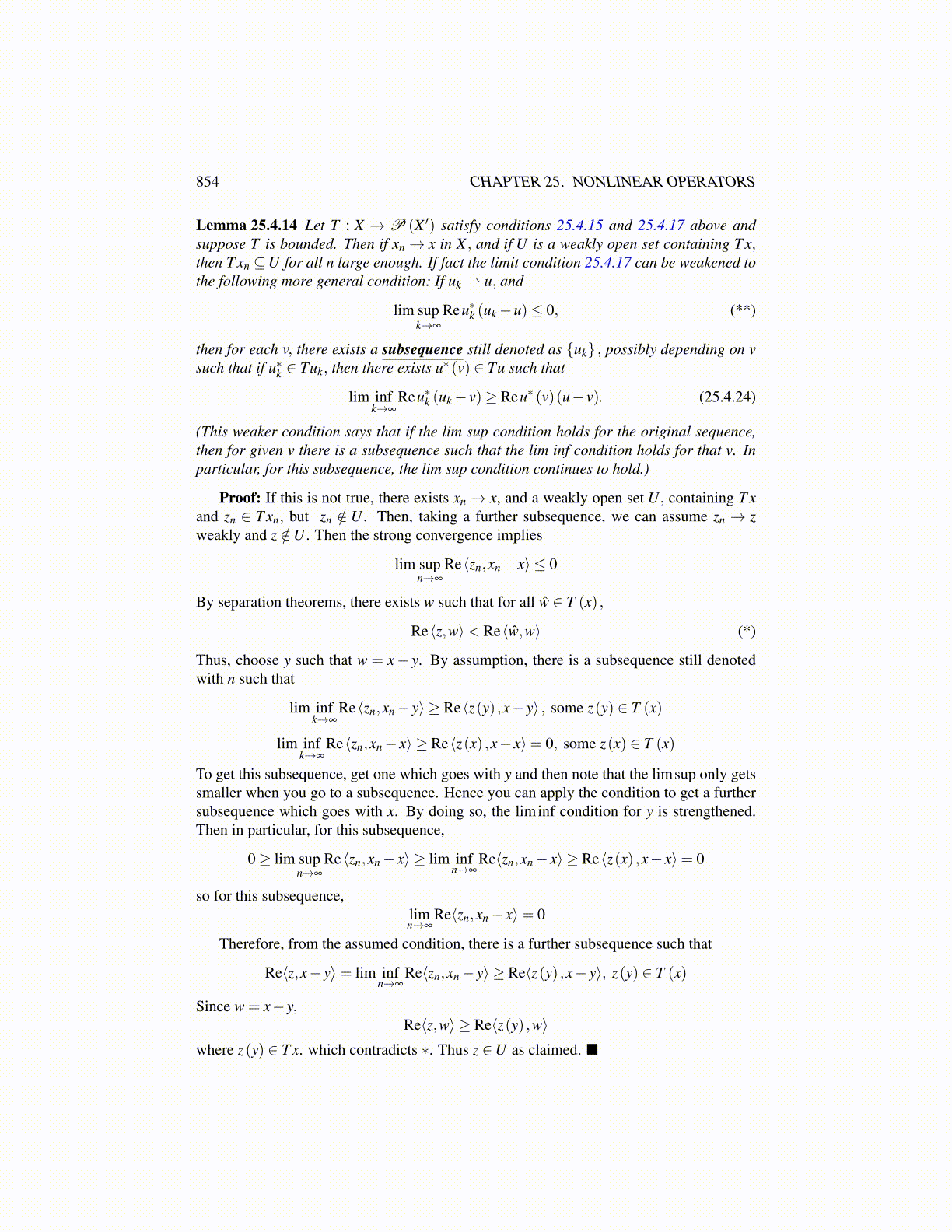
854 CHAPTER 25. NONLINEAR OPERATORS
Lemma 25.4.14 Let T : X →P (X ′) satisfy conditions 25.4.15 and 25.4.17 above andsuppose T is bounded. Then if xn→ x in X , and if U is a weakly open set containing T x,then T xn ⊆U for all n large enough. If fact the limit condition 25.4.17 can be weakened tothe following more general condition: If uk ⇀ u, and
lim supk→∞
Reu∗k (uk−u)≤ 0, (**)
then for each v, there exists a subsequence still denoted as {uk} , possibly depending on vsuch that if u∗k ∈ Tuk, then there exists u∗ (v) ∈ Tu such that
lim infk→∞
Reu∗k (uk− v)≥ Reu∗ (v)(u− v). (25.4.24)
(This weaker condition says that if the lim sup condition holds for the original sequence,then for given v there is a subsequence such that the lim inf condition holds for that v. Inparticular, for this subsequence, the lim sup condition continues to hold.)
Proof: If this is not true, there exists xn→ x, and a weakly open set U, containing T xand zn ∈ T xn, but zn /∈ U . Then, taking a further subsequence, we can assume zn → zweakly and z /∈U . Then the strong convergence implies
lim supn→∞
Re⟨zn,xn− x⟩ ≤ 0
By separation theorems, there exists w such that for all ŵ ∈ T (x) ,
Re⟨z,w⟩< Re⟨ŵ,w⟩ (*)
Thus, choose y such that w = x− y. By assumption, there is a subsequence still denotedwith n such that
lim infk→∞
Re⟨zn,xn− y⟩ ≥ Re⟨z(y) ,x− y⟩ , some z(y) ∈ T (x)
lim infk→∞
Re⟨zn,xn− x⟩ ≥ Re⟨z(x) ,x− x⟩= 0, some z(x) ∈ T (x)
To get this subsequence, get one which goes with y and then note that the limsup only getssmaller when you go to a subsequence. Hence you can apply the condition to get a furthersubsequence which goes with x. By doing so, the liminf condition for y is strengthened.Then in particular, for this subsequence,
0≥ lim supn→∞
Re⟨zn,xn− x⟩ ≥ lim infn→∞
Re⟨zn,xn− x⟩ ≥ Re⟨z(x) ,x− x⟩= 0
so for this subsequence,limn→∞
Re⟨zn,xn− x⟩= 0
Therefore, from the assumed condition, there is a further subsequence such that
Re⟨z,x− y⟩= lim infn→∞
Re⟨zn,xn− y⟩ ≥ Re⟨z(y) ,x− y⟩, z(y) ∈ T (x)
Since w = x− y,Re⟨z,w⟩ ≥ Re⟨z(y) ,w⟩
where z(y) ∈ T x. which contradicts ∗. Thus z ∈U as claimed.